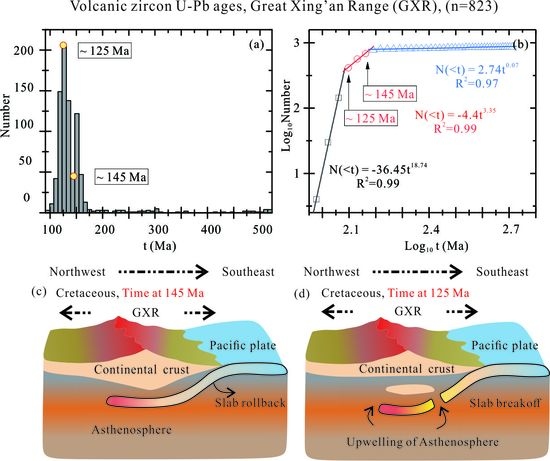Singularity Analysis of Volcanic Ages and Implications for Tectonic Setting in the Mesozoic, Great Xing’an Range, Northeast China
Abstract
:1. Introduction
2. Data and Methods
2.1. Data
2.2. Singularity Analysis
3. Results
4. Discussion
4.1. Advantages of Singularity and Mechanisms of the Power-Law Distribution
4.2. Implications for Tectonic Setting
4.3. Possible Mechanisms Corresponding to Age Transitions
5. Conclusions
Supplementary Materials
Author Contributions
Funding
Acknowledgments
Conflicts of Interest
References
- Jahn, B.M. The Central Asian Orogenic Belt and growth of the continental crust in the Phanerozoic. Geol. Soc. Lond. Spec. Publ. 2004, 226, 73–100. [Google Scholar] [CrossRef]
- Wu, F.; Lin, J.; Wilde, S.; Zhang, X.; Yang, J. Nature and significance of the Early Cretaceous giant igneous event in eastern China. Earth Planet. Sci. Lett. 2005, 233, 103–119. [Google Scholar] [CrossRef]
- Zhang, H.; Wang, F.; Xu, W.; Cao, H.; Pei, F. Petrogenesis of Early-Middle Jurassic intrusive rocks in northern Liaoning and central Jilin provinces, northeast China: Implications for the extent of spatial-temporal overprinting of the Mongol-Okhotsk and Paleo-Pacific tectonic regimes. Lithos 2016, 256, 132–147. [Google Scholar] [CrossRef]
- Zhang, J.; Ge, W.; Wu, F.; Wilde, S.A.; Yang, J.; Liu, X. Large-scale Early Cretaceous volcanic events in the northern Great Xing’an Range, Northeastern China. Lithos 2008, 102, 138–157. [Google Scholar] [CrossRef]
- Meng, Q.R. What drove late Mesozoic extension of the northern China-Mongolia tract? Tectonophysics 2003, 369, 155–174. [Google Scholar] [CrossRef]
- Fan, W.M.; Guo, F.; Wang, Y.J.; Lin, G. Late Mesozoic calc-alkaline volcanism of post-orogenic extension in the northern Da Hinggan Mountains, northeastern China. J. Volcanol. Geotherm. Res. 2003, 121, 115–135. [Google Scholar] [CrossRef]
- Zhu, P.; Cheng, Q.; Zhang, Z.; Wang, Z. Genesis and implications of the Late Jurassic Hailesitai granites in the northern Greater Khingan Range: Evidence from zircon U-Pb dating and Hf isotope. Geol. Mag. 2017, 154, 963–982. [Google Scholar] [CrossRef]
- Wang, F.; Zhou, X.; Zhang, L.; Ying, J.; Zhang, Y.; Wu, F.; Zhu, R. Late Mesozoic volcanism in the Great Xing’an Range (NE China): Timing and implications for the dynamic setting of NE Asia. Earth Planet. Sci. Lett. 2006, 251, 179–198. [Google Scholar] [CrossRef]
- Zhang, J.; Gao, S.; Ge, W.; Wu, F.; Yang, J.; Wilde, S.A.; Li, M. Geochronology of the Mesozoic volcanic rocks in the Great Xing’an Range, northeastern China: Implications for subduction-induced delamination. Chem. Geol. 2010, 276, 144–165. [Google Scholar] [CrossRef]
- Wu, F.; Sun, D.; Ge, W.; Zhang, Y.; Grant, M.L.; Wilde, S.A.; Jahn, B. Geochronology of the Phanerozoic granitoids in northeastern China. J. Asian Earth Sci. 2011, 41, 1–30. [Google Scholar] [CrossRef] [Green Version]
- Wang, T.; Guo, L.; Zhang, L.; Yang, Q.; Zhang, J.; Tong, Y.; Ye, K. Timing and evolution of Jurassic-Cretaceous granitoid magmatisms in the Mongol-Okhotsk belt and adjacent areas, NE Asia: Implications for transition from contractional crustal thickening to extensional thinning and geodynamic settings. J. Asian Earth Sci. 2015, 97, 365–392. [Google Scholar] [CrossRef]
- Cheng, Q. Mapping singularities with stream sediment geochemical data for prediction of undiscovered mineral deposits in Gejiu, Yunnan Province, China. Ore Geol. Rev. 2007, 32, 314–324. [Google Scholar] [CrossRef]
- Lovejoy, S.; Schertzer, D. Scaling and multifractal fields in the solid earth and topography. Nonlinear Process. Geophys. 2007, 14, 293–315. [Google Scholar] [CrossRef]
- Xia, Q.; Zhao, P.; Cheng, Q.; Chen, Y.; Zhang, S. Platinum and Palladium in Coal Rock and Geochemical Anomaly in Eastern Yunnan Province, Southwest China. J. China Univ. Geosci. 2008, 19, 354–362. [Google Scholar]
- Wang, W.; Zhao, J.; Cheng, Q. Fault trace-oriented singularity mapping technique to characterize anisotropic geochemical signatures in Gejiu mineral district, China. J. Geochem. Explor. 2013, 134, 27–37. [Google Scholar] [CrossRef]
- Liu, Y.; Zhou, K.; Cheng, Q. A new method for geochemical anomaly separation based on the distribution patterns of singularity indices. Comput. Geosci. 2017, 105, 139–147. [Google Scholar] [CrossRef]
- Chen, G.; Cheng, Q. Cyclicity and Persistence of Earth’s Evolution Over Time: Wavelet and Fractal Analysis. Geophys. Res. Lett. 2018, 45, 8223–8230. [Google Scholar] [CrossRef]
- Cheng, Q. Singularity analysis of global zircon U-Pb age series and implication of continental crust evolution. Gondwana Res. 2017, 51, 51–63. [Google Scholar] [CrossRef]
- Cheng, Q. Extrapolations of secular trends in magmatic intensity and mantle cooling: Implications for future evolution of plate tectonics. Gondwana Res. 2018, 63, 268–273. [Google Scholar] [CrossRef]
- Cheng, Q. Singularity analysis of magmatic flare-ups caused by India-Asia collisions. J. Geochem. Explor. 2018, 189, 25–31. [Google Scholar] [CrossRef]
- Shen, P.; Pan, H.; Seitmuratova, E.; Jakupova, S. U-Pb zircon, geochemical and Sr–Nd–Hf–O isotopic constraints on age and origin of the ore-bearing intrusions from the Nurkazgan porphyry Cu–Au deposit in Kazakhstan. J. Asian Earth Sci. 2016, 116, 232–248. [Google Scholar] [CrossRef]
- Zhang, C.; Ma, C.; Liao, Q.; Zhang, J.; She, Z. Implications of subduction and subduction zone migration of the Paleo-Pacific Plate beneath eastern North China, based on distribution, geochronology, and geochemistry of Late Mesozoic volcanic rocks. Int. J. Earth Sci. 2011, 100, 1665–1684. [Google Scholar] [CrossRef]
- Cheng, Q. The gliding box method for multifractal modeling. Comput. Geosci. 1999, 25, 1073–1079. [Google Scholar] [CrossRef]
- Zhu, P.; Cheng, Q.; Chen, G. New fractal evidence of Pacific Plate subduction in the late Mesozoic, Great Xing’an Range, Northeast China. J. Earth Sci. 2019, 1–10. [Google Scholar] [CrossRef]
- Newman, M. Power laws, Pareto distributions and Zipf’s law. Contemp. Phys. 2005, 46, 323–351. [Google Scholar] [CrossRef]
- Wang, P.J.; Liu, W.Z.; Wang, S.X.; Song, W.H. 40Ar/39Ar and K/Ar dating on the volcanic rocks in the Song-liao basin, NE China: Constraints on stratigraphy and basin dynamics. Int. J. Earth Sci. 2002, 91, 331–340. [Google Scholar] [CrossRef]
- Ma, X.; Chen, C.; Zhao, J.; Qiao, S.; Zhou, Z. Late Permian intermediate and felsic intrusions in the eastern Central Asian Orogenic Belt: Final-stage magmatic record of Paleo-Asian Oceanic subduction? Lithos 2019, 326, 265–278. [Google Scholar] [CrossRef]
- Fu, D.; Huang, B.; Kusky, T.M.; Li, G.; Wilde, S.A.; Zhou, W.; Yu, Y. A Middle-Permian ophiolitic mélange belt in the Solonker Suture zone, Western Inner Mongolia, China: Implications for the evolution of the Paleo-Asian Ocean. Tectonics 2018, 37, 1292–1320. [Google Scholar] [CrossRef]
- Song, S.; Wang, M.; Xu, X.; Wang, C.; Niu, Y.; Allen, M.B.; Su, L. Ophiolites in the Xing’an-Inner Mongolia accretionary belt of the CAOB: Implications for two cycles of seafloor spreading and accretionary orogenic events. Tectonics 2015, 34, 2221–2248. [Google Scholar] [CrossRef]
- Deng, C.; Sun, D.; Li, G.; Lu, S.; Tang, Z.; Gou, J.; Yang, Y. Early Cretaceous volcanic rocks in the Great Xing’an Range: Late effect of a flat-slab subduction. J. Geodyn. 2019, 124, 38–51. [Google Scholar] [CrossRef]
- Zhang, X.; Yuan, L.; Xue, F.; Yan, X.; Mao, Q. Early Permian A-type granites from central Inner Mongolia, North China: Magmatic tracer of post-collisional tectonics and oceanic crustal recycling. Gondwana Res. 2015, 28, 311–327. [Google Scholar] [CrossRef]
- McMillan, P.F.; Stanley, H.E. Going supercritical. Nat. Phys. 2010, 6, 479–480. [Google Scholar] [CrossRef]
- Cheng, Q. Multifractality and spatial statistics. Comput. Geosci. 1999, 25, 949–961. [Google Scholar] [CrossRef]
- Liu, Y.; Cheng, Q.; Xia, Q.; Wang, X. Application of singularity analysis for mineral potential identification using geochemical data: A case study: Nanling W-Sn-Mo polymetallic metallogenic belt, South China. J. Geochem. Explor. 2013, 134, 61–72. [Google Scholar] [CrossRef]
- Cheng, Q. Fractal density and singularity analysis of heat flow over ocean ridges. Sci. Rep. 2016, 6, 19167. [Google Scholar]
- Wang, W.; Cheng, Q.; Zhang, S.; Zhao, J. Anisotropic singularity: A novel way to characterize controlling effects of geological processes on mineralization. J. Geochem. Explor. 2018, 189, 32–41. [Google Scholar] [CrossRef]
- Eby, G.N. The A-type granitoids: A review of their occurrence and chemical characteristics and speculations on their petrogenesis. Lithos 1990, 26, 115–134. [Google Scholar] [CrossRef]
- Frost, C.D.; Frost, B.R. On ferroan (A-type) granitoids: Their compositional variability and modes of origin. J. Petrol. 2010, 52, 39–53. [Google Scholar] [CrossRef]
- Kusky, T.M.; Windley, B.F.; Wang, L.; Wang, Z.; Li, X.; Zhu, P. Flat slab subduction, trench suction, and craton destruction: Comparison of the North China, Wyoming, and Brazilian cratons. Tectonophysics 2014, 630, 208–221. [Google Scholar] [CrossRef]
- Li, Z.; Li, X. Formation of the 1300-km-wide intracontinental orogen and post-orogenic magmatic province in Mesozoic South China: A flat-slab subduction model. Geology 2007, 35, 179–182. [Google Scholar] [CrossRef]
- Wang, T.; Zheng, Y.; Zhang, J.; Zeng, L.; Donskaya, T.; Guo, L.; Li, J. Pattern and kinematic polarity of late Mesozoic extension in continental NE Asia: Perspectives from metamorphic core complexes. Tectonics 2011, 30, 1–27. [Google Scholar] [CrossRef]
- Liu, J.; Davis, G.A.; Lin, Z.; Wu, F. The Liaonan metamorphic core complex, Southeastern Liaoning Province, North China: A likely contributor to Cretaceous rotation of Eastern Liaoning, Korea and contiguous areas. Tectonophysics 2005, 407, 65–80. [Google Scholar] [CrossRef]
- Lin, W.; Faure, M.; Chen, Y.; Ji, W.; Wang, F.; Wu, L.; Charles, N.; Wang, J.; Wang, Q. Late Mesozoic compressional to extensional tectonics in the Yiwulüshan massif, NE China and its bearing on the evolution of the Yinshan-Yanshan orogenic belt, Part I: Structural analyses and geochronological constraints. Gondwana Res. 2013, 23, 54–77. [Google Scholar] [CrossRef]
- Lin, W.; Charles, N.; Chen, Y.; Chen, K.; Faure, M.; Wu, L.; Wang, F.; Li, Q.; Wang, J.; Wang, Q. Late Mesozoic compressional to extensional tectonics in the Yiwulüshan massif, NE China and their bearing on the Yinshan-Yanshan orogenic belt, Part II: Anisotropy of magnetic susceptibility and gravity modeling. Gondwana Res. 2013, 23, 78–94. [Google Scholar] [CrossRef]
- Liu, J.; Shen, L.; Ji, M.; Guan, H.; Zhang, Z.; Zhao, Z. The Liaonan/Wanfu metamorphic core complexes in the Liaodong Peninsula: Two stages of exhumation and constraints on the destruction of the North China Craton. Tectonics 2013, 32, 1121–1141. [Google Scholar] [CrossRef]
- Dmitrienko, L.V.; Li, S.Z.; Cao, X.Z.; Suo, Y.H.; Wang, Y.M.; Dai, L.M.; Somerville, I.D. Large-scale morpho-tectonics of the ocean-continent transition zone between the Western Pacific Ocean and the East Asian Continent: A link of deep process to the Earth’s surface system. Geol. J. 2016, 51, 263–285. [Google Scholar] [CrossRef]
- Huangfu, P.; Wang, Y.; Cawood, P.A.; Li, Z.; Fan, W.; Gerya, T.V. Thermo-mechanical controls of flat subduction: Insights from numerical modeling. Gondwana Res. 2016, 40, 170–183. [Google Scholar] [CrossRef] [Green Version]
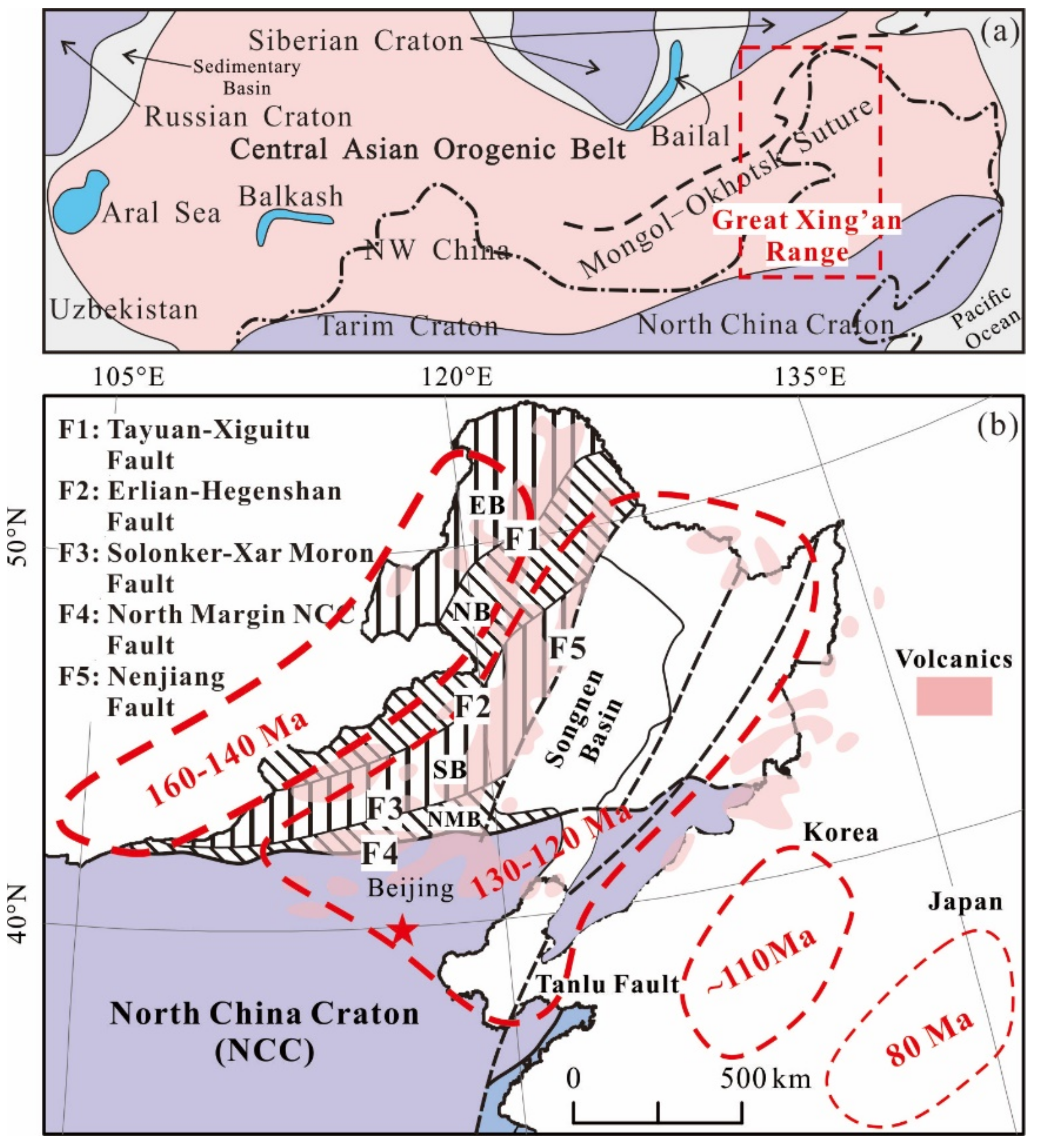
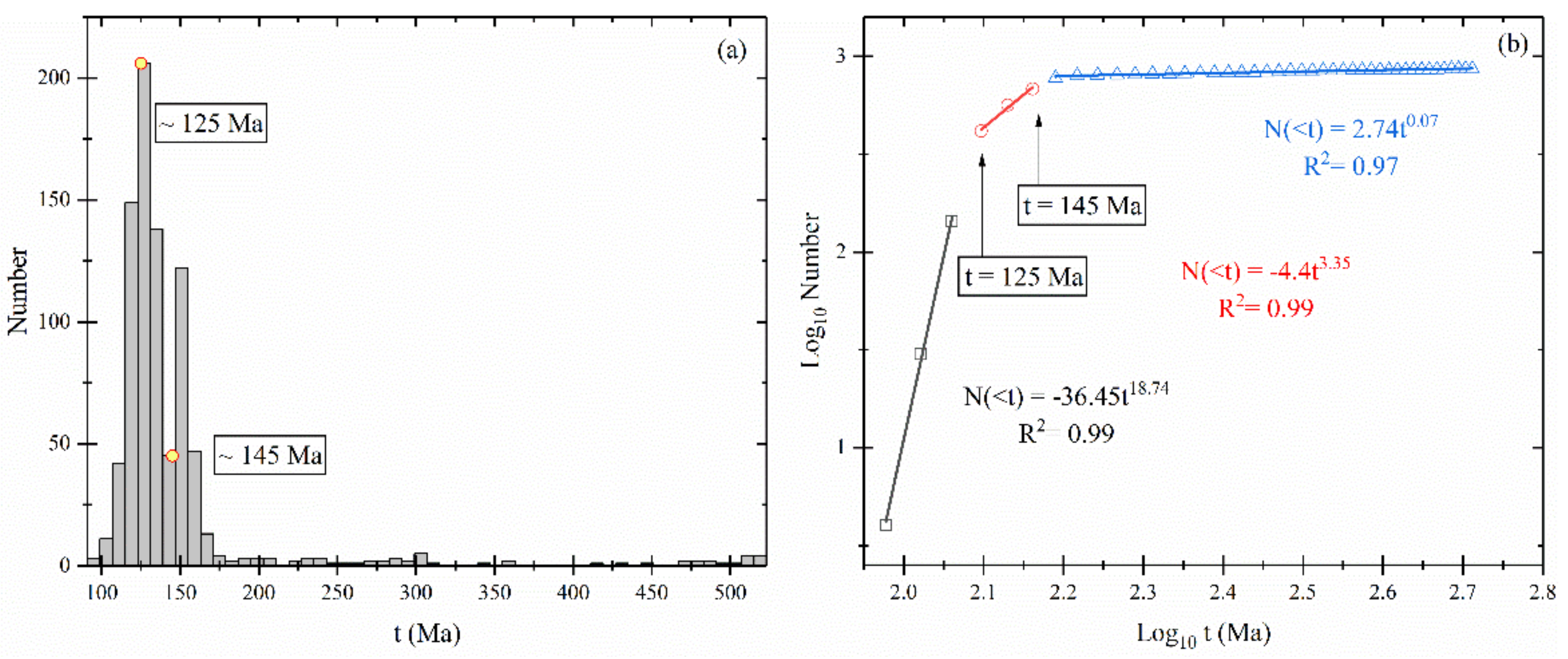
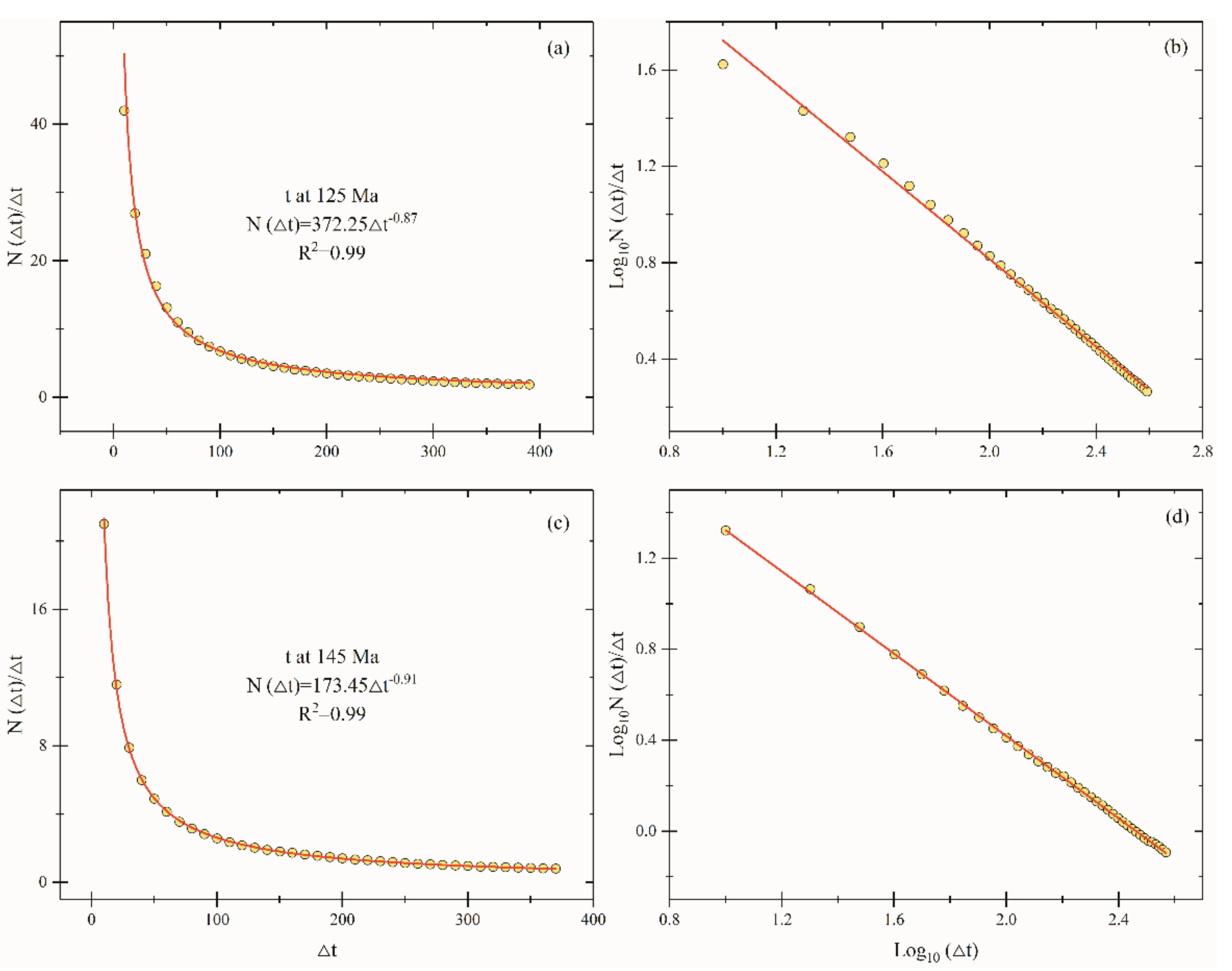
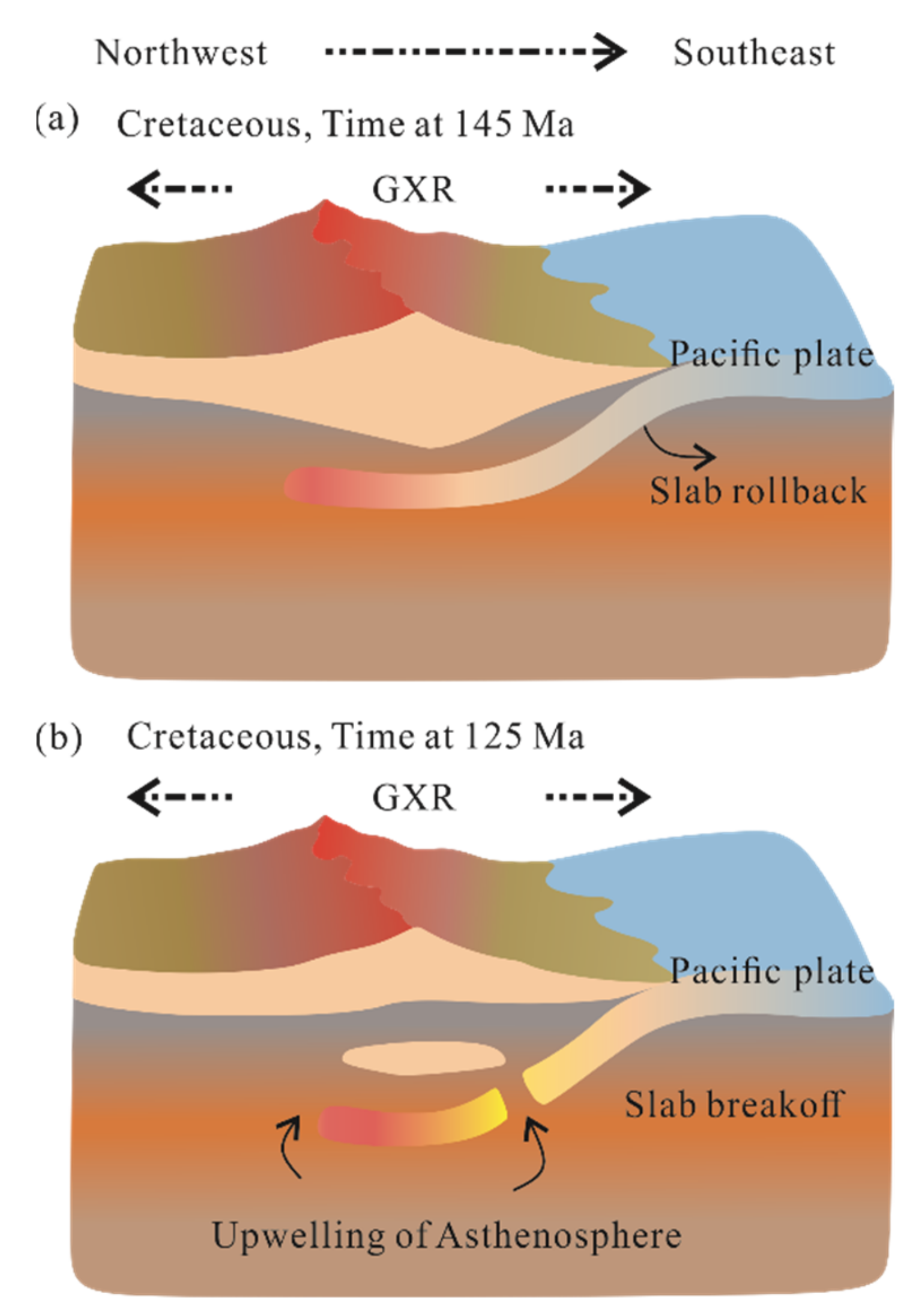
© 2019 by the authors. Licensee MDPI, Basel, Switzerland. This article is an open access article distributed under the terms and conditions of the Creative Commons Attribution (CC BY) license (http://creativecommons.org/licenses/by/4.0/).
Share and Cite
Zhu, P.; Cheng, Q. Singularity Analysis of Volcanic Ages and Implications for Tectonic Setting in the Mesozoic, Great Xing’an Range, Northeast China. Minerals 2019, 9, 419. https://doi.org/10.3390/min9070419
Zhu P, Cheng Q. Singularity Analysis of Volcanic Ages and Implications for Tectonic Setting in the Mesozoic, Great Xing’an Range, Northeast China. Minerals. 2019; 9(7):419. https://doi.org/10.3390/min9070419
Chicago/Turabian StyleZhu, Pingping, and Qiuming Cheng. 2019. "Singularity Analysis of Volcanic Ages and Implications for Tectonic Setting in the Mesozoic, Great Xing’an Range, Northeast China" Minerals 9, no. 7: 419. https://doi.org/10.3390/min9070419





